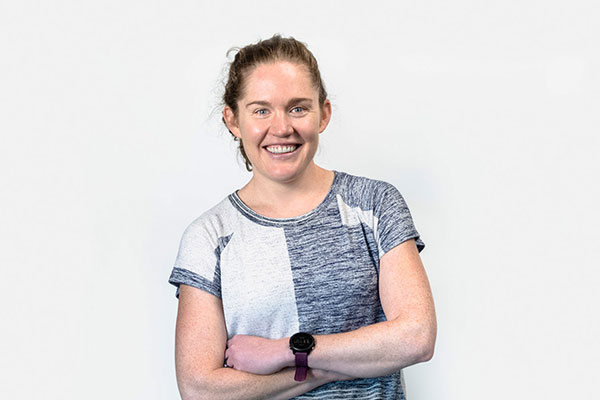DOES THE FIT OF FOOTWEAR MATTER FOR PERFORMANCE
By  Dan Feeney
Dan Feeney  Kate harrison
Kate harrison
Follow on ![]() @Dfeeney31 and @running_geek
@Dfeeney31 and @running_geek

Quick Takes
- Work shoes should help avoid falls, prevent puncture injuries, and reduce overuse injuries.
- Fit is especially challenging when you need to include a voluminous safety toe to protect workers from impact.
- We focus on locking in the heel through an instep hold, which provides a secure fit even with a safety toe.

Dan’s Take
Our lab is laser-focused on optimizing performance. Enhancing the fit of workwear shoes is critical to high output and staying healthy. From a biomechanics point of view, workwear shoes are challenging to study because daily work activities differ considerably. Thus, scientists struggle to collect meaningful data where we can control all external confounding variables. During our first endeavor into workwear, we used a simple but repeatable test in the laboratory that covered walking and movements that required stability. If we can enhance fit and performance in an hour-and-a-half study, we believe the benefits will magnify during an arduous 8-hour workday.

Kate’s Take
As a runner, I consider a two-hour session of work in my shoes a long time. For professionals who spend 8 -10 hours per day working in their footwear, a good fit is critical for comfort and maintaining one's ability to work at a high level throughout the workday. Improving the fit of work boots and shoes presented a challenge to our team because we needed to build around the necessary safety features. Over the past year, we have researched novel configurations that offer occupational athletes fit safety on all fronts.

BOA’s Take
At BOA, we thrive on making the best gear even better. BOA has a long history on workwear shoes in Northern Europe and Scandinavia, partnering with Sievi, Solid Gear, Elten, and many others. Additionally, recent product launches from Red Wing, Wolverine, Mizuno, and Asics, integrate our PerformFitTM Wrap Technology, which provides a locked in, dialed in, and confident fit. The Performance Fit Lab and the Customer Product Development teams at BOA work hard to design and test innovative fit configurations based on our learnings.

Research on the Topic
Despite serving individuals who spend a lot of time executing arduous activities in their footwear, there is surprisingly little scientific research on work shoes and boots. Julie Steele and her research group in Australia have meticulously studied the needs and desires of workers to identify potential improvements in work boots. To start, they asked a group of coal miners how they perceived their workwear. Frustratingly, but perhaps not shockingly, more than half of workers reported foot problems, not to mention a high incidence of pain at the ankle, knee, and back. Most workers felt that their footwear contributed to the pain they experienced.
Julie Steele's subsequent study provided more evidence that footwear contributes to pain and injury among workers. Steele and colleagues measured the interior dimensions of work boots and compared them to the shapes of workers’ feet. Their results should make retailers rethink how we fit boots. Most people buy footwear according to one's foot length. However, even if the boot length is correct, discrepancies in other foot dimensions can contribute to lower extremity pain. It is critical that the shoe also accommodates heel circumference and height at the instep and the balls of the feet.
With safety concerns top of mind for those designing work shoes, it is not surprising that they deprioritize fit. The risk of slipping requires grippy outsoles. The risk of puncture requires thick, stiff materials. And the risk of impact requires steel or composite toes. As a result, it is challenging to wrap the irregular shape of a foot well. Despite the myriad of concerns for health and safety, a poor fit is sure to cause pain and make it more difficult for workers to balance in challenging and unpredictable terrain.
For example, in a gumboot with no mechanism to tighten the instep or shaft of the boot, researchers found higher peak pressures under both the heel and toes during walking. These high pressures may explain the high risk of foot pain and stress fractures seen in workers. In contrast, lace-up boots reduced these pressures. Further, the gumboots required greater muscular activation of the thigh muscles, which researchers considered necessary to prevent trips and slips in poorly fitting footwear. This increased muscular activation may lead to increased fatigue by the end of the day.

How we test
We considered several study designs when trying to uncover the impact of fit on long-duration workdays. Ultimately, we decided to begin with a simple, single-day protocol where we test each worker in three configurations (see below) during a single test session. This testing method is the gold standard for biomechanics since slight day-to-day variations in how a person moves can obfuscate significant differences caused by footwear. In this way, we limit external variables such as mood and fatigue when analyzing the data. The drawback is that we may miss changes that accumulate over an entire day.
The scientific protocol comprised workers walking for five minutes in each shoe while we measured 3-dimensional forces under their feet, 2-dimensional pressures between their foot and midsole, and the positions of their bodies using infrared cameras. After each walking trial, workers performed two types of single-leg landings where they jump from a height, land on one foot, and stabilize as quickly as possible. These types of landings are routine biomechanical tests used to assess dynamic stability. While workers walked on our treadmill, we measured how quickly force loaded onto the body following impact, referred to as vertical loading rate. We also measured how much braking force workers applied during walking. We utilized pressure-insoles to gain quantitative measurements for fit, a technique pioneered by our lab. During the single-leg landing test, we measured the time and joint work required for workers to stabilize.

The results
What follows are preliminary results based on ten workers. While a sample size of ten may be sufficient to detect statistical significance in some scenarios, our research team is careful not to provide specific numerical findings to the broad public until a full-scale (usually 30+ person) study is complete. This early look into data provides a glimpse into how we test workwear products with our brand partners to improve fit for products hitting shelves - physical or virtual - near you.
When we start investigating new segments, we quantify how BOA configurations affect the pressure between the athlete and product. Our general hypothesis is that if we provide a locked in fit for the midsole, we allow athletes to move optimally with the rest of the shoe (sometimes called foot-shoe coupling). For walking, we focus on two key metrics. The first is variability in heel pressure (mathematically, the coefficient of variation for heel pressure). The second is the mean pressures under the toes. We hypothesize that, in both cases, lower values are advantageous because they indicate reduced heel slip and less toe clawing for support. We saw evidence to support this in our PerformFit Wrap solution. As you can see in the pressure maps below, we observed the most substantial improvements from the Standard Lace baseline in our PerformFit Wrap configuration. Our Lace Replacement was the second-best option.

Plantar pressure data obtained from 99 foot locations from a single subject, averaged at three parts of the gait cycle during 30-seconds of walking. The top part of each image shows the toe pressure, and the bottom is the heel. The three columns for each configuration represent three phases of the gait cycle: heel strike, mid stance, and toe off. We use this data to see how different shoe upper configurations impact plantar loading.
After verifying that we improved connection to the midsole, we focused on how improved foot-shoe coupling impacts performance. During walking, we observed improvements in Endurance & Health. Specifically, workers walked with a reduced vertical loading rate (the rate of force produced), peak braking force, and braking impulse (the sum of all braking forces during the stance phase) at the same speed. These findings may indicate that superior fitting footwear could reduce injury risk and increase efficiency.
Consistent with the pressure changes, our PerformFit Wrap configuration performed best, with Lace Replacement performing second best. When looking at how quickly workers stabilized after jumping off a platform, we saw inconsistent results. No single shoe upper configuration performed best. This result could partially be due to the smaller number of observations obtained in single-leg landings; we ask workers to jump off a box five times in each configuration. For the walking test, in comparison, we record 1 minute of force data at 1000 Hz and collect 90-100 footsteps. With that much data in walking, we obtain a robust estimate of an individual's walking performance. To gain this same level of confidence in single-leg landings, we need more subjects.

For retailers and consumers
Finding the right shoes for a long day on the job is critical for longevity and, likely, focus and productivity. We are working diligently with our brand partners to lock in the instep and heel for workwear products. We continue to improve fit for products with our PerformFit Wrap panels, which work to evenly distribute pressure across the top of your foot while locking in the instep and heel, allowing you to take full advantage of the technologies in the rest of the shoe. BOA shoes also enable workers to effortlessly fine-tune fit by adjusting tightness depending on foot swell and the task at hand. For a long day on the job, you want to be confident your shoes will fit from start to finish.
Find us on Twitter @Dfeeney31 and @running_geek.